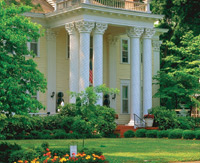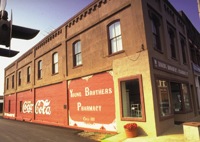 All photos courtesy Cartersville-Bartow County CVB
All photos courtesy Cartersville-Bartow County CVBInstead of getting lost in the shadow of Atlanta, its big neighbor 45 miles to the south on Interstate 75, Cartersville, Ga., takes advantage of its close but not too close location.
The Cartersville-Bartow County Convention and Visitors Bureau points out to groups that Atlanta attractions such as a Braves baseball game or a Broadway play at the Fox Theatre are just 45 minutes away while also proudly promoting a bevy of major local attractions. After all, its website is www.notatlanta.org
The attractions range in age from 1,000-year-old Indian mounds considered some of the most complete in the Southeast to two major world-class museums that opened in the past decade.
“You first must see the two Smithsonian-affiliated museums, Tellus and the Booth Western Art Museum,” said Regina Wheeler, deputy director of the CVB. “Tellus is brand new — it only opened in January 2009 — and has already had more than 200,000 visitors. It has been very well received by groups.”
 The 125,000-square-foot museum, whose official name is Tellus: Northwest Georgia Science Museum, incorporated and expanded on the former Weinman Mineral Museum, which closed at the end of July 2007.
The 125,000-square-foot museum, whose official name is Tellus: Northwest Georgia Science Museum, incorporated and expanded on the former Weinman Mineral Museum, which closed at the end of July 2007.
“Only about a quarter of the old collection was on display. It has finally gotten its just due,” said Wheeler.
Considered one of the largest and most comprehensive collections of its kind in the Southeast, the Weinman gallery has more than 4,000 rocks, gems and minerals on display.
But the large museum has more than rocks and minerals. One gallery traces developments in science and technology related to automobiles, aircraft and space travel, and another features a 40-foot Tyrannosaurus rex among a collection of dinosaurs and fossils.
“They have a 120-seat planetarium with four different shows each day and a special show during the holidays,” said Wheeler. “They also have an observatory, and on special events, they have it open for stargazing. The Tellus is all about education.”
Although the Booth Western Art Museum has been open since 2003, Wheeler said it is like new with the opening of a major expansion last October.
“The new exhibit space added half the size of the museum onto it,” she said. “And they have redone all the existing galleries. It is truly a brand-new wonderful experience. I am in love with it all over again.”
 The second-largest art museum in Georgia, the now 120,000-square-foot Booth Western Art Museum has a large collection of historic and contemporary Western art, along with galleries for Civil War art, Native American artifacts and an interesting presidential gallery.
The second-largest art museum in Georgia, the now 120,000-square-foot Booth Western Art Museum has a large collection of historic and contemporary Western art, along with galleries for Civil War art, Native American artifacts and an interesting presidential gallery.
“They have a portrait of and hand-signed letter from every president of the United States,” said Wheeler. “The topics range from their stock portfolio to specifics related to the Booth. Lincoln, for example, deals with the pending execution of a group of Native Americans. It’s very poignant. It commands your attention.
“They have added a section of native craft items. It is very, very early pristine beadwork and basketry. It is the finest work I think I have ever seen. It was all done by hand. It makes you appreciate the artistry in their everyday lives.”
As its name indicates, the Booth’s primary emphasis is on Western art, and it has the largest permanent exhibition space for such art in the United States. Its paintings and sculptures range from 19th-century giants George Catlin, Charles Russell and Frederic Remington to contemporary trendsetters such as Thom Ross, Nelson Boren, Billy Scheck and Donna Howell-Sickles.
The Booth will showcase more than 100 photographs by landscape photographer Ansel Adams from Sept. 25 to March 13. The prints were originally created by Adams in his California darkroom and given to the Friends of Photography to represent his legacy.
 Wheeler said that although state budget cuts have reduced the Etowah Indian Mounds State Historic Site to being open only on Thursday, Friday and Saturday, “it is still worth the experience.”
Wheeler said that although state budget cuts have reduced the Etowah Indian Mounds State Historic Site to being open only on Thursday, Friday and Saturday, “it is still worth the experience.”
The 54-acre site contains six earthen mounds, a plaza, borrow pits and a defensive ditch of a large settlement of Native Americans from the Mississippian Culture who lived at the site between A.D. 1000 and A.D. 1550.
The tallest mound, believed to have been the platform for the home of the head priest, is more than 60 feet high and covers more than an acre. Steps lead to the top, where you get a good view of the Etowah River Valley.
A museum contains artifacts found in excavations of one of the mounds.
The lives of three remarkable Cartersville residents are featured at Rose Lawn, a restored Victorian mansion downtown. There is memorabilia about 19th-century evangelist Samuel Porter Jones, for whom Nashville’s Ryman Auditorium was built, and Rebecca Latimer Felton, the first woman to serve in the U.S. Senate.
“He was the Billy Graham of the late 19th century,” said Wheeler. “She was a U.S. senator for one day. She took the seat of her husband when he died. She was Sam Jones’ teacher.
“Groups can arrange for a tea and cookie reception. The cookies are from Lottie Moon’s recipe.”
Moon, a famous missionary, originated her Lottie Moon Christmas offering for foreign missions in Cartersville when local churchwomen collected pennies to finance her work in China.
“She would bake these cookies there to befriend children,” said Wheeler.
 She said the current director is restoring the house’s famous rose gardens, and the Jones family has helped with plants that are descendants of those from the house’s original gardens.
She said the current director is restoring the house’s famous rose gardens, and the Jones family has helped with plants that are descendants of those from the house’s original gardens.
An annual arts festival held at Rose Lawn since 1975 has high-quality art and heritage crafts from the Southeast.
The ornate Italianate villa at Barnsley Gardens in nearby Adairsville has been restored in a different and distinctive way. Originally built in the 1840s by wealthy businessman Godfrey Barnsley, the house had modern plumbing, marble from Italy and France, and furnishings from around the world. Its elaborate gardens were designed by pioneering 19th-century landscape architect Andrew Jackson Downing.
The house was severely damaged during the Civil War and by an early-20th-century tornado, and fell into disrepair and ruin after Barnsley’s descendants sold it in 1942.
Prince Hubertus Fugger purchased the estate in 1988 and revived and expanded the gardens, which now have more than 200 varieties of roses. He also stabilized and restored the ruins of the manor house, whose roofless brick walls provide a distinctive backdrop for special events.
Barnsley Gardens is now a resort on 1,400 acres with luxurious cottages, an 18-hole championship golf course, three restaurants and a full-service spa. A museum provides background on the site’s interesting history.
“Adairsville is a little historic town and a great place to walk and shop,” said Wheeler.
The 1902 Stock Exchange was restored in the early 1990s by Rita Pritchard, who relocated her Cobb County antiques shop there. In addition to her store, the building has Maggie Mae’s Cafe and Tea Room and the Cora Harris Bookstore on the first floor and the Public Square Opera House upstairs.
The opera house presents seasonal dinner theater in February and October and a Christmas dinner theater on December weekends. It also presents two one-day performances, near Mother’s Day in May and on July 4.
Researching your trip:
Cartersville-Bartow County Convention and Visitors Bureau
www.notatlanta.org
800-733-2280











